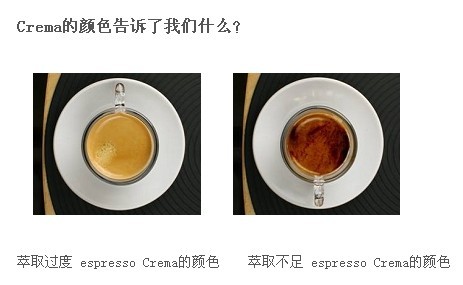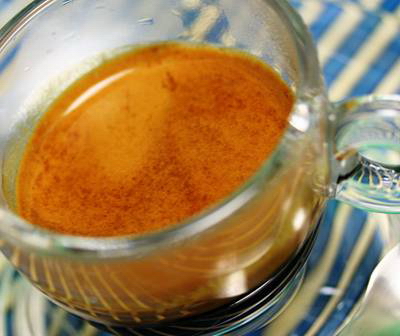Basic Analysis of barista training what is the Crema of Coffee
What is Crema? How did it come about? During the roasting process, a large amount of carbon dioxide is produced in the coffee beans, most of which will be emitted during the cooling process, and a small amount will remain inside. Grinding will release these gases, so coffee must be made as soon as possible after grinding.
When hot water hits the coffee powder under high pressure, it will emulsify the insoluble oils of the coffee powder, and at the same time it will dissolve a large amount of carbon dioxide in a supersaturated manner, which is much greater than the solubility of hot water under normal pressure. This is why countless fine bubbles appear immediately when the liquid flows from the handle. But that doesn't explain Crema completely. Open a can of Coke and you'll see countless bubbles coming up, but they don't last.
To create a stable foam, we need some bubbles and some compounds to "wrap" the bubbles, making the bubble structure stable and elastic. The process of this chemical reaction can be thought of as the action of a surfactant. Unlike milk foam, which uses protein eggs to complete this process, coffee uses a substance called melanin. It is produced by a combination of chemical reactions during baking, a process that scientists do not know much about. Protein and melanin are not hydrophilic substances, so when hot water hits, they naturally distribute on the surface of the bubble, so they can contact more air, thus creating countless tiny bubbles, so we have-foam. There is also something else-fat, which often destroys the foam structure (think about it, when we make cakes, we must remove the egg yolk, otherwise the fat in the egg yolk will lead to the failure of the egg white.)
So will the oil in the coffee cause crema to disappear quickly within minutes? The answer is either right or wrong. Surfactants dissolve in water, and gravity pulls them off the surface of the foam along with the water, making the foam fragile, elastic, and quickly disappearing. The rate at which foam disappears is related to the rate at which water is pulled away, but a properly brewed cup of coffee lasts longer on the surface of the foam than a fast-brewed cup because the liquid is stronger than a fast-brewed coffee, as evidenced by our taste.

Crema should be a light brownish red color, but yellow-white or very black, almost burnt brown. What does it mean? The answer comes from the drink, because crema is actually bubbles of carbon dioxide wrapped around brewed coffee, so darker foam means stronger coffee is a natural assumption. But it's actually very difficult to tell the color of coffee apart unless you dilute two cups of coffee or look at it under a microscope.
Another factor also plays an important role: the reflection of light from the foam means that the coffee looks lighter through the foam than it actually is. And the smaller the foam, the greater the effect, so even if the espresso itself is very dark, it may look very light (which explains why dark beer has very white foam at the top).
The 15-second espresso usually has a whiter crema because it is lighter. Coffee powder is water quenched for a shorter time, and the viscosity of coffee is lower than that of 25 seconds. For the same reason, coffee brewed at a lower water temperature will also be weaker, because it does not have enough energy to dissolve the substances in the coffee (it should be that the solubility of the lower water temperature is low, not the so-called energy). This also explains why over-quenching can lead to dark, charred crema.
Arabica Coffee vs Robusta
There has long been a theory that roberstadt allows punching to produce better crema. This is true, because robersta contains only half the aroma components and aromatic oils of arabica coffee. This means that less oil is extracted into the coffee, thus reducing the impact of oil on foam stability. Therefore, increasing the robersta will reduce the overall amount of oil extracted from the coffee powder, which means that you have a higher probability of making a more stable and richer Crema.
Food technologists will also tell you that reducing the amount of oil makes coffee appear to make more body at first, and that the lack of oil makes it less like pure arabica coffee. Therefore, it is generally used to add 5%-10% robersta, which will not significantly affect the quality of coffee, but can ensure the stability of crema, however, this theory cannot explain the source of extra crema. Other articles explain that robersta may contain different sugars, thus causing this change.
I often collect espresso with its own crema, and one exception is Yellow Bourbon from a farm in Brazil, which is so sweet that if it's used to make espresso, even if it's baked nine days ago, it still produces a very rich, stable crema. Even when the liquid is drained and the foam on top dries, it remains stable.
There are many uncertainties affecting crema, including how coffee preserves carbon dioxide foam, how many types and amounts of fats are in coffee and how they are extracted into the cup.

Tiger Spotted/Striped
We often say that there must be red specks on the surface of coffee, but specks are actually ground very fine coffee powder, which is washed out at an early stage of the process. I can often see them spread out over the rim of the cup at first and then spread over the entire surface as the stamping process progresses. This implies that this cup is not only well brewed, but also very well ground, suitable for making espresso.
If the grind is very uniform, it will have the opposite effect as expected, and the coffee powder will not be closely united. For example: one pool, filled with volleyball, another pool, filled with volleyball, football, tennis mixture, who will be more dense. If the coffee grounds each have a different shape and size, and all can lock together, of course, there is still some room for water to flow normally.
In the cup, tiger stripes mean that the ground coffee is in the right range (which explains why the grinder is not set to be as fine as possible).
What Crema can tell us and what Crema cannot tell us:
Crema can tell us:
1, coffee is fresh: a large number of robersta beans can let us see a very rich foam, so we can not see the speed of foam disappearance to judge the freshness of coffee. Fresh coffee appears crema throughout the process, stopping only when a large amount of water is present, thus separating two very distinct stages of the process. Old coffees often see a thin, detached foam appear in the process of ejection. The coffee produced is often thin and watery, meaning less crema and disappears faster.
Degree of coffee extraction: The deeper the Crema, the more dissolved matter enters the cup.
Uniformity of coffee extraction: The more stable Crema is, the better and stronger the coffee we make, and it means that there are fewer cracks in the coffee powder and fewer mistakes in the production process.
What Crema cannot tell us:
1, coffee is not good to drink: as long as fresh enough, then poor beans, then rotten baking can also produce rich crema.
The oil in coffee is properly emulsified: For a long time, many people, including me, thought that Crema told us how much oil was extracted from coffee, but the theory told us that the more oil, the less foam. If you try to make espresso with 5-6bar pressure, you will find that you can still make a lot of crema, but the coffee tastes very flat due to lack of oil and aroma.
Crema, it's not complicated.
Espresso and crema are often made more complicated than is actually needed. Crema is a very simple link in the entire espresso making process.
Espresso has three main elements: water, oil and foam. The espresso body is colloidal (the legendary soy sauce paste), the oil in the coffee is emulsified by hot water at high temperature and high pressure, forming the colloid of the body, which is extremely stable. The foam on the surface of espresso disappears faster than the gel.
Crema is still one of the pleasures of espresso after removing the mysterious aura that surrounds it, its honeycomb structure stores a lot of aromatic substances, and when the structure collapses, it releases a lot of fragrance, which brings pleasure to our sight and smell.
Important Notice :
前街咖啡 FrontStreet Coffee has moved to new addredd:
FrontStreet Coffee Address: 315,Donghua East Road,GuangZhou
Tel:020 38364473
- Prev

Puerto Rico coffee smells Caribbean
Sometimes, the tongue is a key that can open up different spaces between memory and imagination. For example, about the taste of the Caribbean Sea, start with that cup of Puerto Rico coffee in the afternoon. Taking a deep breath, the aroma of coffee slowly reached his chest through his throat. In recent years, the number of coffee aficionados has soared. Since coffee landed in Taiwan in 1884, coffee development in China has experienced
- Next

Baristas train tips for distinguishing the freshness of coffee beans
Nose smell: fresh coffee beans smell strong fragrance, otherwise tasteless or bad smell. Look at it: good coffee beans are complete in shape and full in size. On the contrary, the shape is incomplete. Hand pressure: fresh coffee beans are fresh and crisp, and the fragrance comes out when they crack. Color: dark black coffee beans, the coffee brewed has a bitter taste; yellow coffee beans, the coffee brewed has a sour taste.
Related
- What documents do you need to go through to open a coffee shop? coffee shop coffee shop certificate processing process
- How to purchase Coffee beans in small Cafe how to choose a suitable supplier for domestic Coffee supply Company
- How to drink Starbucks Fragrance White Coffee? how to make Australian White Coffee? what Italian coffee beans are recommended?
- The Story of Flora Coffee: the name of Flora Coffee Bean and the implication of the Flowers on Florna Coffee
- How much does a cup of coffee cost? How much is the profit of a cup of coffee? What is the profit of the coffee shop in a year?
- Yunnan small Coffee, known as "fragrant Coffee", introduces the characteristics of Alpine Arabica Coffee producing areas in Yunnan, China
- 2023 latest Starbucks full menu price list how much is a cup of Starbucks coffee what is better to drink the most popular hot and cold drinks recommended
- Starbucks different kinds of Coffee Price list Starbucks menu 2023 Top Ten Best drinks in Starbucks
- Starbucks Spring praise Comprehensive matching Coffee Bean theme Story Packaging implication and taste description
- The cost of a cup of coffee latte American coffee cost price and selling price

